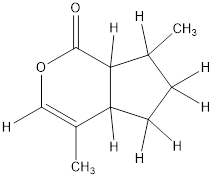
Concept explainers
(a)
Interpretation:
The type of organic compound which is nepetalactone needs to be determined.
Concept introduction:
The type of an organic compound depends on the arrangement of different elements present in it. It depends on the different functional groups in the molecules.
Explanation of Solution
Nepetalactone is known to be bicyclic monoterpenoid organic compound. There are 10 carbon atoms which are derived from isoprene having 2 fused rings. Out of the 2 rings, 1 is cyclopentane and other is lactone. The compound belongs to the class of iridoids.
(b)
Interpretation:
The structural formula for nepetalactone needs to be drawn with missing hydrogen atoms.
Concept introduction:
A structural formula tells about the actual number of atoms present in the molecule as well as their arrangement in the molecule.
Explanation of Solution
The given structure of nepetalactone is as follows:

Here, H atoms are missing in the structure thus the complete structure with H atoms is represented as follows:

(c)
Interpretation:
The molecular formula of the given nepetalactone needs to be determined.
Concept introduction:
The molecular formula tells about the actual number of atoms of different elements present in the molecule.
Explanation of Solution
The given structure of nepetalactone is as follows:

Here, H atoms are missing in the structure thus the complete structure with H atoms is represented as follows:

From the above structure, there are 10 carbon atoms, 14 hydrogen atoms and 2 oxygen atoms. Thus, the molecular formula is
Chapter 22 Solutions
Chemistry: Matter and Change
Additional Science Textbook Solutions
Inorganic Chemistry
CHEMISTRY-TEXT
Essential Organic Chemistry (3rd Edition)
General Chemistry: Principles and Modern Applications (11th Edition)
General, Organic, and Biological Chemistry (3rd Edition)
Organic Chemistry
 ChemistryChemistryISBN:9781305957404Author:Steven S. Zumdahl, Susan A. Zumdahl, Donald J. DeCostePublisher:Cengage Learning
ChemistryChemistryISBN:9781305957404Author:Steven S. Zumdahl, Susan A. Zumdahl, Donald J. DeCostePublisher:Cengage Learning ChemistryChemistryISBN:9781259911156Author:Raymond Chang Dr., Jason Overby ProfessorPublisher:McGraw-Hill Education
ChemistryChemistryISBN:9781259911156Author:Raymond Chang Dr., Jason Overby ProfessorPublisher:McGraw-Hill Education Principles of Instrumental AnalysisChemistryISBN:9781305577213Author:Douglas A. Skoog, F. James Holler, Stanley R. CrouchPublisher:Cengage Learning
Principles of Instrumental AnalysisChemistryISBN:9781305577213Author:Douglas A. Skoog, F. James Holler, Stanley R. CrouchPublisher:Cengage Learning Organic ChemistryChemistryISBN:9780078021558Author:Janice Gorzynski Smith Dr.Publisher:McGraw-Hill Education
Organic ChemistryChemistryISBN:9780078021558Author:Janice Gorzynski Smith Dr.Publisher:McGraw-Hill Education Chemistry: Principles and ReactionsChemistryISBN:9781305079373Author:William L. Masterton, Cecile N. HurleyPublisher:Cengage Learning
Chemistry: Principles and ReactionsChemistryISBN:9781305079373Author:William L. Masterton, Cecile N. HurleyPublisher:Cengage Learning Elementary Principles of Chemical Processes, Bind...ChemistryISBN:9781118431221Author:Richard M. Felder, Ronald W. Rousseau, Lisa G. BullardPublisher:WILEY
Elementary Principles of Chemical Processes, Bind...ChemistryISBN:9781118431221Author:Richard M. Felder, Ronald W. Rousseau, Lisa G. BullardPublisher:WILEY





